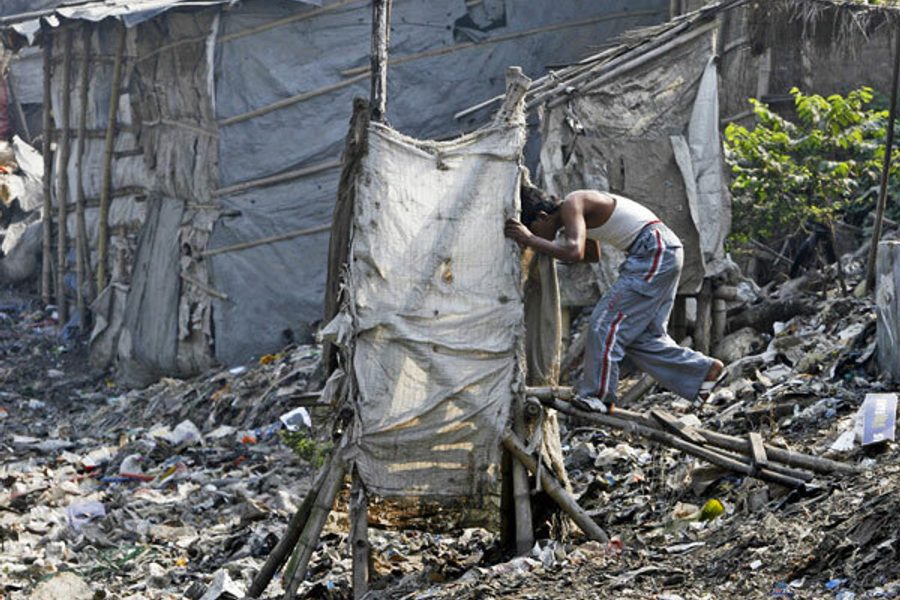Toilet Ecology
The Big Necessity argues toilets and sewers are the key to improved sanitation. But reality is more complex - and toxic
Laura Orlando

Rose George argues in her book The Big Necessity: The Unmentionable World of Human Waste and Why It Matters (Metropolitan, October) that the “big necessity” is a toilet.
For 2.6 billion people, George writes, the lack of access to a hygienic toilet can result in “crippled guts and killed children.” Every 20 seconds a child dies because of abysmal sanitation conditions, mostly from exposure to infectious agents, like the Vibrio cholerae bacteria, which move from gut to gut by way of feces. Contain the feces and the pathogens are contained, too.
It is a simple and straightforward story that George tells with ease as she crisscrosses the globe profiling efforts to improve sanitation for the world’s poor.
But the problem is more complex than she allows. There is nothing simple about toilets – or “necessities,” as they were once called.
A toilet can be a hole in the ground (as in the case of an outhouse) into which urine and feces are deposited, which then can seep into the groundwater. Or it can be the means via which this human excreta is flushed into a sewer system, where it is joined by storm water and industrial wastes. But can either disposal system be considered hygienic?
Transnational institutions, such as the World Bank and WaterAid – a British charity started by large private water corporations – play an enormous role in framing the entire discussion of what proper “sanitation” entails.
The tropes promoted by such organizations seem unquestionable.
First, poor people will defecate anywhere if they are not provided “toilets” (here a euphemism for latrine); and they must pay for these “toilets” or they will not value them.
Second, where there is institutional funding, sewers and sewage treatment are the best ways to manage domestic and industrial waste.
These two postulations are related because latrines – stinking, unpleasant devices – drive people to flush toilets and the accompanying sewer systems.
Sewers are big business for corporations, governments and donor agencies. In the United States, total spending on sewer and water from 1991 to 2005 was $841 billion.
In the ’70s and ’80s, for example, the U.S. Agency for International Development (USAID) spent $3.45 billion on water and sanitation projects in Egypt. Every penny of this money went to U.S. corporations.
George is an unapologetic fan of sewers. She calls them “unassailable as the default option of how to dispose of human excreta in sophisticated, wealthy places.” This is a mistake.
Sewers look good on World Bank loan portfolios and the income statements of the companies that build them. But from the point of view of long-term, sustainable public and environmental health, they are a disaster.
It is true that deaths from typhoid and cholera – the great waterborne killers of the 19th centuries’ open sewers – were greatly reduced with the combined use of closed pipe sewers and drinking water treatment. But a greater and more complex group of killers is now in the sewage or result from sewage treatment itself. And this is a threat that George gives short shift.
In the ’40s, wartime production and a subsequent push by government and the chemical industry to get new synthetic chemicals into commercial use resulted in massive quantities of such chemicals entering the sewers after being discarded by industry and households, as well as “run off” from roads.
Current sewage treatment is designed to address only a handful of parameters: biodegradable organics like proteins, carbohydrates and fats from food and excreta; and suspended solids.
Yet each day, 42 billion pounds of chemical substances are produced or imported in the United States for commercial and industrial uses. George ignores the fact that no technologies exist to “treat” or make “disappear” carcinogenic, mutagenic, teratogenic and endocrine-disrupting chemicals once they are added to the sewer.
Some of these incidentally end up in the sludge, the inevitable byproduct of sewage treatment. Sludge – called “biosolids” by the sewer and sludge industry – is a toxic brew of chemicals, heavy metals, bacteria, viruses and whatever else that is repelled by water (hydrophobic) or removed from the wastewater in the treatment process.
The disposal of sludge is a contentious issue. George writes about this in the chapter “Battle of Biosolids.” Shall we get rid of it in the water, the land or the air?
Most municipal sludge used to be dumped into the ocean. But public outrage at the ocean being used “as a dump” prompted a congressional ban. Since 1988, when Congress passed the Ocean Dumping Ban Act, the Environmental Protection Agency has promoted “land application.” This means that right now, tens of thousands of acres of U.S. agricultural and other land are the dump for the noxious dregs of municipal wastewater treatment. The result is poisoned land, dead livestock and sick people.
For instance, in February 2008, a federal court judge ruled that 1,700 acres of Andy McElmurray’s farm in Georgia had been ruined by sludge applications over a 10-year period. Hundreds of his dairy cattle died and the milk supplies in several states had been contaminated with high levels of thallium (the primary toxin in rat poison) that had been present in the sewage sludge spread on crops fed to the dairy cows.
And across the country, thousands of people have been sickened by sludge. You can read some of their stories at Sludge News.
The Millennium Development Goals adopted by 189 nations during the U.N. Millennium Summit in 2000 set a target to reduce by half the proportion of people without access to safe drinking water and basic sanitation (at last count 3.7 billion people).
Counting toilets and linear feet of sewers has become the measure of evaluating success or failure in the sanitation sector.
This focus on the number of people “without adequate sanitation” allows us to ignore the underlying socioeconomic and political troubles people face.
And George, by failing to address such issues, underscores the need for a deeper, more a critical analysis of the causes and remedies.
Until we have a criticism of conventional sanitation that encompasses not only the technologies but also the systems – political, technological, economic, managerial that drive the technologies – we will be left with exhortations, like George’s, to “fix the problem,” but with no approach that actually can.
The needed critique will take into account on-site technologies vs. central collection, source-separation vs. mixing-then-fixing technologies. Hopefully, the choice of developing sanitation systems that are culturally appropriate, ecologically responsible and functionally sustainable will then sound downright conventional.

I hope you found this article important. Before you leave, I want to ask you to consider supporting our work with a donation. In These Times needs readers like you to help sustain our mission. We don’t depend on—or want—corporate advertising or deep-pocketed billionaires to fund our journalism. We’re supported by you, the reader, so we can focus on covering the issues that matter most to the progressive movement without fear or compromise.
Our work isn’t hidden behind a paywall because of people like you who support our journalism. We want to keep it that way. If you value the work we do and the movements we cover, please consider donating to In These Times.








